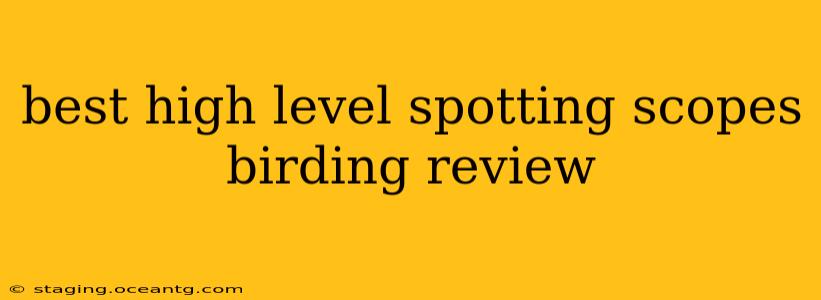Spotting scopes are invaluable tools for serious birders, allowing you to get incredibly close to your feathered subjects without disturbing them. But with so many models available, choosing the right one can feel overwhelming. This review focuses on high-level spotting scopes, perfect for discerning birders who demand the best in optical performance and durability. We'll delve into key features, compare top contenders, and address frequently asked questions to help you make an informed decision.
What Makes a High-Level Spotting Scope?
Before we dive into specific models, let's define what constitutes a "high-level" spotting scope for birding. These scopes generally share several key characteristics:
- Exceptional Optical Quality: Superior lens coatings, high-quality glass (like ED or fluorite), and precise manufacturing result in incredibly sharp, clear images with minimal chromatic aberration (color fringing).
- Robust Construction: High-level scopes are built to withstand the rigors of fieldwork, featuring durable materials and weather-resistant seals.
- Advanced Features: This may include features like variable magnification, angled eyepieces for comfortable viewing, tripod adaptability, and robust carrying cases.
- High Magnification Range: While not always the only determining factor, high-level scopes often offer a wider range of magnification, allowing for versatile observation at various distances.
Top Contenders: A Comparison of High-End Spotting Scopes
While specific models change frequently based on availability and new releases, several brands consistently deliver high-performance spotting scopes. These include, but aren't limited to, brands like Swarovski, Zeiss, Leica, and Kowa. Each brand boasts its unique strengths and caters to slightly different needs and budgets. A detailed comparison would be extensive, and reviews should always be up-to-date with the latest models. Instead, let's address common concerns and questions.
Frequently Asked Questions (FAQs)
This section will address common questions regarding high-level spotting scopes for birding, based on typical online searches.
What magnification is best for birding?
The ideal magnification depends on the distance to your subject and the size of the bird. A versatile scope with a variable magnification range (e.g., 20-60x) offers excellent flexibility. Lower magnifications are useful for quickly locating birds, while higher magnifications allow for detailed observation. However, excessively high magnification can result in a shaky image, requiring a sturdy tripod.
What is the difference between angled and straight spotting scopes?
Angled spotting scopes provide a more comfortable viewing position, especially when used for extended periods. Straight scopes are better suited for use with a digiscoping setup or when observing from a stable position like a vehicle.
What type of tripod do I need for a high-level spotting scope?
A sturdy, high-quality tripod is crucial for stability, especially at higher magnifications. Look for a tripod specifically designed for spotting scopes, capable of handling the weight and ensuring a smooth panning and tilting motion. Consider features like carbon fiber legs for lightness, and a fluid head for smooth adjustments.
How much should I spend on a high-level spotting scope?
High-level spotting scopes are a significant investment. Prices vary widely, but expect to spend several hundred to several thousand dollars, depending on the brand, features, and magnification range. It’s wise to carefully consider your budget and needs before making a purchase. Don't hesitate to seek advice from experienced birders or a reputable retailer.
Are there any lightweight options available among high-level spotting scopes?
Yes, advancements in materials science have resulted in lighter high-performance scopes. Many manufacturers utilize carbon fiber and other lightweight materials without compromising optical quality or durability. However, even lightweight scopes still benefit from a stable tripod.
How do I clean my spotting scope lenses?
Proper lens care is essential to maintaining optical performance. Use only high-quality lens cleaning supplies, such as a blower bulb, microfiber cloths, and lens cleaning solution. Avoid harsh chemicals or abrasive materials. Gentle cleaning with a blower bulb followed by a microfiber cloth should be sufficient for most cleaning needs.
This comprehensive review provides a foundation for choosing a high-level spotting scope for birding. Remember to thoroughly research specific models from reputable brands, reading detailed reviews from independent sources to ensure you make the best choice for your needs and budget. Happy birding!
